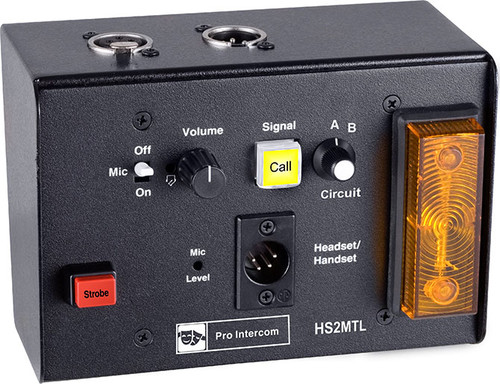Frequency response has been carefully shaped to optimize both intelligibility and long term listening comfort. A mic limiter circuit reduces overload distortion. The high bridging impedance ensures that system and sidetone levels do not vary as other stations are switched in and out of the circuit. The front panel contains controls for switching the microphone on and off, for controlling listening level, and for signaling. A recessed, screwdriver-adjust control is provided for varying the level of the user's voice to be heard in his own earphone (Sidetone).
The HS2TL has male and female 3-pin XLR connectors on the rear panel for connection of the station and daisy chaining on to the next station in the circuit. (The HS2MTL has 6-pin XLRs.) The headset or handset connects to the station via a front-panel 4-pin XLR connector. The Xenon lamp on the front panel lights whenever anyone on the same circuit presses their signal light button. A built in timer keeps the signal light circuit activated for 4 seconds and the lamp has a 2Hz frequency, providing 7 to 8 flashes each time. The Xenon may be switched on or off with the red push button marked 'strobe'.
The component board of the HS2TL is mounted to a thick metal mounting plate. Long-life switches and controls are used. The 'T' cabinet is constructed to withstand the rugged use associated with touring. The HS2TL is compatible with Clear-Com® and other lesser-known (unbalanced 200W) headset intercom systems.
- Power requirement:
- 24 ~ 30 VDC, 10mA quiescent, 120 mA max. (w/xenon signal lamp lit)
- Headphone output:
- 8 ~ 4KW acceptable, 200W ideal.
- Microphone input:
- 200 ~ 600W dynamic
- Sidetone rejection:
- > 50dB
- Audio bridging impedance:
- 200W unbalanced





